The Pony Express
Of all the larger-than-life legends that animate the annals of the Wild West, none looms larger than that of the Pony Express. As is typical of frontier adventures, accounts of the Pony Express are often laced with considerable exaggeration, but in this case the facts are unusually impressive. Beginning in April 1860, the Pony Express ran twice a week between St. Joseph, Missouri, and Sacramento, California, where it was linked with San Francisco by steamship. Pony Express riders halved the time it took to carry news to and from the West Coast, making the 1,966-mile trek in just 10 days. Eighty riders (including teenaged William “Buffalo Bill” Cody, who made the record single run of 322 miles) were employed to race between the 190 stations en route, switching horses every 10-15 miles and averaging 75 miles per run—day or night, in all kinds of weather, across 120°F deserts or snowbound Sierra passes.

Covering nearly 2,000 miles of the wildest and ruggedest land on the frontier, the Pony Express established the first high-speed link between the two coasts. At a time when the nation was divided against itself, with the Civil War looming on the horizon, the Pony Express connection played a key role in keeping the valuable mines of California and Nevada in Union hands. A private enterprise that lasted just 18 months and lost considerable amounts of money before being put out of business for good, the Pony Express proved that overground connections across the still-wild western United States were both necessary and possible.

The completion on October 28, 1861, of the transcontinental telegraph made the Pony Express obsolete overnight, and not so much as a saddle survives from this legendary endeavor, apart from a few postmarked letters. Along with the various statues and plaques marking the Pony Express route, the most evocative sites survive in the dry Nevada desert, within easy access of the US-50 highway (aka the Loneliest Road). East of Fallon, for example, the highway runs right on top of the old Pony Express route, and the remains of two relay stations can still be seen. One is at Sand Springs, at the foot of Sand Mountain. More substantial remains survive at Cold Springs, 32 miles east, where plaques recount the history and a trail brings you to what was once among the most isolated and dangerous of the Pony Express stations.
The Pony Express Re-Ride
Every June, Wild West aficionados re-create the era in the Pony Express Re-Ride, in which a team of 550 riders follows the old route as closely as possible. The Re-Ride alternates direction each year, saddling up from Sacramento, CA in even years, and in odd years beginning the ride in St. Joseph, MO. You can apply to have a commemorative or personal letter carried by horseback . Letters receive a special hand-stamped postmark (and final delivery by the US Postal Service).














